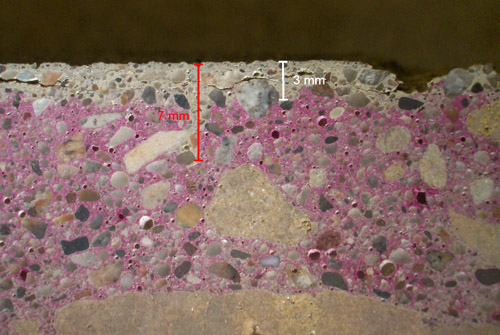Latest News
Factors Affecting Concrete Curing
Factors Affecting Concrete Curing
NOVEMBER 5, 2014
By Terry Swor and Gerard Moulzolf, AET St. Paul
Thanks to last year’s brutal winter, many of you are noticing scaling or mortar flaking in new exterior concrete flatwork such as sidewalks, driveways, parking lots, and curbs and gutters. This superficial deterioration can be the result of many factors, including inadequate concrete curing. As we move into prime concrete placement weather, consider the cure.
Proper concrete curing involves providing and/or maintaining adequate moisture and temperature to permit the portland cement in the concrete mix to properly hydrate and gain strength with time. The freeze-thaw durability of concrete is dependent upon three factors:
- The incorporation of fine air voids (air entrainment) in the concrete.
- Proper finishing.
- Curing for the development of durability strength.
These factors result in beneficial properties that maximize water-tightness, freeze-thaw durability and volume stability.
.jpg)
A common complaint. This surmountable curb was cured in fall 2013 and suffered from the harsh winter; scaling and pop-outs are apparent.
It’s important, however, to note that curing is the final step in the nearly 70-step, highly comple
x process of concrete production and placement. As in any process, missing or poorly performing any step can negatively impact the outcome (i.e., finished concrete) in terms of appearance and sustainability.
Proper curing is not only necessary; it’s critical. But proper curing practices are often overlooked due to a number of factors such as scheduling, environmental constraints, and aesthetics. Granted, these factors present some very hard choices on the part of the construction team/owner.
Environmental conditions
The Upper Midwest’s typical early-winter weather and its potential for numerous freeze-thaw cycles can wreak havoc on early-age concrete, especially concrete that isn’t properly finished and cured.
Design concrete strength, which at 4500 psi is the minimum strength specified to resist repetitive freeze-thaw cycles, can be attained under proper ambient conditions at 28 days. The longer the curing process, the greater likelihood of reaching the design strength.
However, the practicalities of modern construction scheduling do not permit a 28-day curing interval. Not incorporating plans for providing the best finishing and curing at the time of your work may prove costly if winter weather comes early.
Early-age concrete that reaches its design strength may still be relatively porous. As a result, design strength doesn’t necessarily equal durability strength.
Concrete requires additional time for the complete hydration of the cement to fill pore spaces and capillaries, which, if unfilled, can represent avenues for significant moisture intrusion leading to saturation. The critical saturation of this paste can overwhelm even properly air entrained early-age concrete.
In addition, research and experience suggest that concrete given time before winter to significantly dry after proper curing will perform better in real-life durability testing.
Aesthetic requirements
Concrete can be cured through the use of water and various chemicals called curing compounds/sealers. Certain curing practices can affect the appearance and wear resistance of the finished concrete. For example, the use of polyethylene, burlap, or a combined product called “burlene” can result in color variations, termed “tiger striping,” to the finished concrete when differential drying has occurred.
Likewise, some departments of transportation may specify the use of a curing compound for their roads and bridges, which is very effective for curing but its potential for non-uniform color and wear is not aesthetically acceptable for most other commercial and residential applications.

Carbonation (unstained paste) proceeds up to 3 mm deep in a freshly sawcut and lapped cross section of concrete exposed to pH indicator. Note sub-horizontal microcracking (incipient scaling) within the carbonated paste. Carbonated paste (low pH) is a sign of compromised surface paste and is not freeze-thaw resistant.
Timing
Curing should take place immediately after concrete is placed and finished; not hours later, and certainly not on the following day. It is critical for early-age concrete to be subjected to moisture and temperatures above 50 degrees Fahrenheit for appropriate strength gain. Low humidity and even a slight wind can quickly compromise surface paste and result in a network of fine, random surface cracks, known as “crazing cracks,” which generally occur within 24 hours after placement. Furthermore, if the concrete dries out or temperatures dip to near freezing, its strength and durability can be compromised. Construction schedules should allow for curing to take place right away, and with the proper materials.
Qualified professionals
The curing of concrete is an art as well as a science. It requires a skilled professional to coordinate activities with the producer and to perform the proper placement, finishing, and curing techniques. Make sure the professionals you choose for your job are qualified as such by the American Concrete Institute’s Certified Concrete Finisher program or similar accreditation.
For further reading:
-
Aggregate & Ready Mix Association of Minnesota’s Curing Guidelines brochure – www.armofmn.com/resources
- “Curing Concrete,” by Peter C. Taylor, 2014 CRC Press.
- Dr. Kim Basham’s recent presentation on “Avoiding Surface Defects on Exterior Slabs” (presented to the Minnesota Concrete Council on May 15, 2014) – www.minnesotaconcretecouncil.com
Terry Swor is AET’s CEO and can be reached at tswor@amengtest.com. Gerard Moulzolf, VP, is AET’s petrographics and chemistry manager and can be reached at gmoulzolf@amengtest.com.
What's New
-

Young Professionals Spotlight
March 25, 2024
-

APWA-MN Education Programs
March 25, 2024
-
Apply for the Young Professionals Stipend: Attend PWX Atlanta
February 23, 2024



